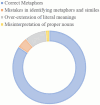Large language models prompt engineering as a method for embodied cognitive linguistic representation: a case study of political metaphors in Trump's discourse
- PMID: 40636042
- PMCID: PMC12239739
- DOI: 10.3389/fpsyg.2025.1591408
Large language models prompt engineering as a method for embodied cognitive linguistic representation: a case study of political metaphors in Trump's discourse
Abstract
Embodied-Cognitive Linguistics inherits and further develops the core concepts of Cognitive Linguistics, maintaining a focus on embodied cognition and conceptual metaphors. It emphasizes that language is not merely a cognitive phenomenon but also a product of human social interactions and economic conditions. From this perspective, metaphors extend beyond their simple linguistic representation and become essential structures of human cognitive expression. Political metaphors, in particular, are instrumental in shaping public ideology and emotional engagement, a phenomenon clearly demonstrated in the political speeches of Donald Trump. With rapid advancements in large language models (LLMs) technology, traditional approaches to metaphor identification are undergoing significant transformation. By leveraging the advanced text parsing and generation capabilities of LLMs, new opportunities emerge for the automatic detection and nuanced analysis of political metaphors. This study employs a critical metaphor analysis (CMA) framework, integrated with a chain-of-thought-based prompt engineering (PE) technique, utilizing the ChatGPT-4.0 Python environment to identify and examine metaphors in Trump's speeches. The results reveal that Trump strategically employs metaphors derived from diverse source domains-such as Movement and Direction, Illness and Health and Force-to resonate emotionally with his audience. Methodologically, while LLMs demonstrate considerable strengths in analyzing political discourse, challenges remain in areas such as semantic differentiation and expression. Future research will focus on optimizing these models, conducting comparative analyses with traditional methods, and exploring their applicability in cross-cultural contexts, with the goal of providing more precise and effective tools for both natural language processing (NLP) and political linguistics research.
Keywords: american studies; cognitive linguistics; embodied cognition; large language models; metaphor identification; political discourse.
Copyright © 2025 Meng, Li and Sun.
Conflict of interest statement
The authors declare that the research was conducted in the absence of any commercial or financial relationships that could be construed as a potential conflict of interest.
Figures
References
-
- Cheng B. (2023). The large language model represented by Chatgpt opens up a huge new space for economics and other social science research paradigms. J. Econ. 3, 589–614. doi: 10.12012/CJoE2023-0032 - DOI
-
- De Vassimom Manela D., Errington D., Fisher T., van Breugel B., Minervini P. (2021). “Stereotype and skew: quantifying gender bias in pre-trained and fine-tuned language models,” in Proceedings of the 16th conference of the European chapter of the Association for Computational Linguistics: Main volume. (Eds.) Merlo P., Tiedemann J., Tsarfaty R. (Stroudsburg: ACL; ). 2232–2242.
-
- Fairclough N. (2001). Critical Discourse Analysis: The Critical Study of Language. (2nd ed.). Routledge. doi: 10.4324/9781315834368 - DOI
-
- Floridi L., Chiriatti M. (2020). Gpt-3: its nature, scope, limits, and consequences. Mind. Mach. 30, 681–694. doi: 10.1007/s11023-020-09548-1 - DOI
-
- Gibbs R. (2006). Embodiment and cognitive science. Cambridge: Cambridge University Press.
LinkOut - more resources
Full Text Sources






